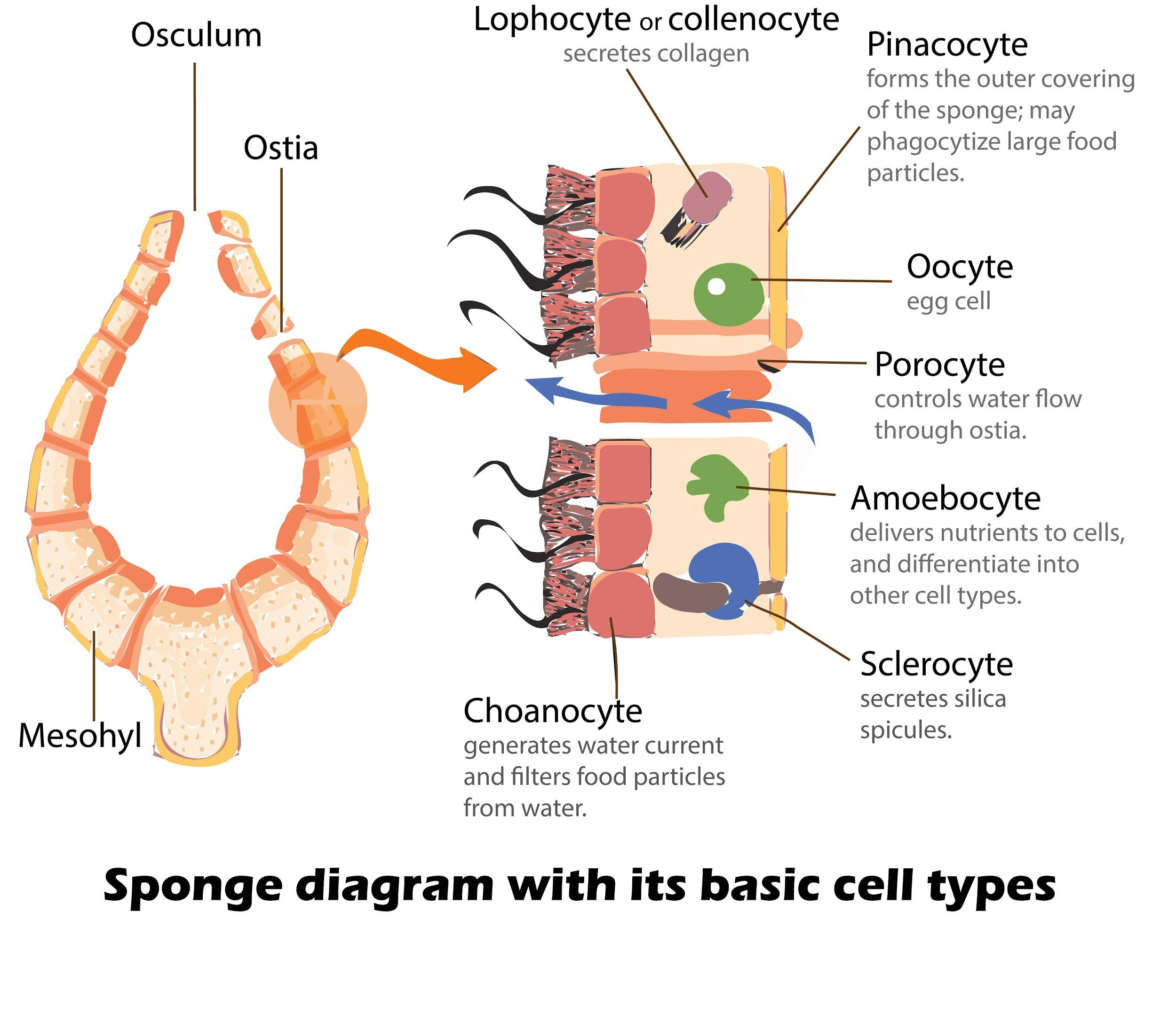
Which amoebocyte of sponges is responsible for forming endoskeleton?
(a) Scleroblast cells
(b) Archaeocytes
(c) Porocytes
(d) Chromocytes
Answer
517.5k+ views
Hint: Endoskeleton is an organism's internal support system, consisting of mineralized tissues. Spicules are structural elements found in most of the sponges that shape the endoskeleton.
Complete answer:
Scleroblast cells are the structure formed by partial fusion of ameboid cells (sclerocytes), which then separates once more. Its members secrete one of the spicules, from which the sponge endoskeleton is formed. Amoebocytes are motile cells found in the sponges of Phylum Porifera and similar organisms like starfish, sea urchins, snails, and mollusks. These cells, as the name implies, resemble an amoeba, moving around by extending its cytoplasm (called pseudopodia, meaning 'false feet'). The coolest part about amoebocytes though is that they are totipotent.
Archaeocytes secrete galectin which acts as a cellular glue and holds together all the parts of the spicule.
Lophocytes secrete collagen fibrils which allow flexibility and pliability of the endoskeleton. Collagen fibrils are not a part of spicules but they give their gel- like consistency to the mesohyl.
Porocytes are tubular cells that constitute the pores of a sponge called ostia.

So, the correct answer is ‘scleroblast cells.’
Additional Information:
- Sponges regulate their different physiological processes through a variety of mechanisms although they are simple organisms. These mechanisms regulate metabolism, locomotion, and reproduction.
- Sclerocytes are specialized amoebocytes which secrete biosilica (silica dioxide), which is a calcium- binding substance. Spicule is given strength and rigidity by biosilica and calcium.
Note: Like some of the vertebrates' white blood cells, amoebocytes are present in blood or body fluid in many animals and play a role in the organism's defense against pathogens. An amoebocyte can also digest and distribute food, dispose of waste, form skeletal fibers, combat infections, and turn into other cell types, depending on the species.
Complete answer:
Scleroblast cells are the structure formed by partial fusion of ameboid cells (sclerocytes), which then separates once more. Its members secrete one of the spicules, from which the sponge endoskeleton is formed. Amoebocytes are motile cells found in the sponges of Phylum Porifera and similar organisms like starfish, sea urchins, snails, and mollusks. These cells, as the name implies, resemble an amoeba, moving around by extending its cytoplasm (called pseudopodia, meaning 'false feet'). The coolest part about amoebocytes though is that they are totipotent.
Archaeocytes secrete galectin which acts as a cellular glue and holds together all the parts of the spicule.
Lophocytes secrete collagen fibrils which allow flexibility and pliability of the endoskeleton. Collagen fibrils are not a part of spicules but they give their gel- like consistency to the mesohyl.
Porocytes are tubular cells that constitute the pores of a sponge called ostia.

So, the correct answer is ‘scleroblast cells.’
Additional Information:
- Sponges regulate their different physiological processes through a variety of mechanisms although they are simple organisms. These mechanisms regulate metabolism, locomotion, and reproduction.
- Sclerocytes are specialized amoebocytes which secrete biosilica (silica dioxide), which is a calcium- binding substance. Spicule is given strength and rigidity by biosilica and calcium.
Note: Like some of the vertebrates' white blood cells, amoebocytes are present in blood or body fluid in many animals and play a role in the organism's defense against pathogens. An amoebocyte can also digest and distribute food, dispose of waste, form skeletal fibers, combat infections, and turn into other cell types, depending on the species.
Recently Updated Pages
Master Class 11 Computer Science: Engaging Questions & Answers for Success

Master Class 11 Accountancy: Engaging Questions & Answers for Success

Master Class 11 Physics: Engaging Questions & Answers for Success

Master Class 11 Business Studies: Engaging Questions & Answers for Success

Master Class 11 Maths: Engaging Questions & Answers for Success

Master Class 11 Chemistry: Engaging Questions & Answers for Success

Trending doubts
Which one is a true fish A Jellyfish B Starfish C Dogfish class 11 biology CBSE

Difference Between Prokaryotic Cells and Eukaryotic Cells

1 ton equals to A 100 kg B 1000 kg C 10 kg D 10000 class 11 physics CBSE

One Metric ton is equal to kg A 10000 B 1000 C 100 class 11 physics CBSE

How much is 23 kg in pounds class 11 chemistry CBSE

Net gain of ATP in glycolysis a 6 b 2 c 4 d 8 class 11 biology CBSE




